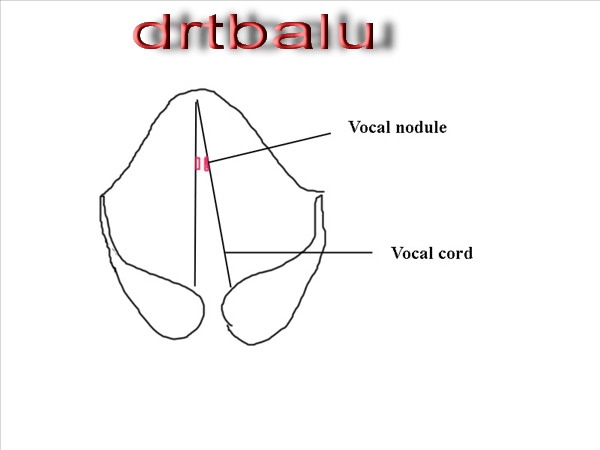Vocal Nodule
Contents
Synonyms:
Singer's nodule, Teacher's nodule.
This disorder frequently affects children and adults. In children it appears as spindle shaped thickenings of the edges of the vocal cords, whereas in adults they appear as more localised thickenings, varying from small points - nodules. These nodules typically appear at the junction of the anterior and middle 1/3 of the vocal cords. They appear almost aways symmetrically.
Pathophysiology:
Are caused by a combination of overtaxing and incorrect use of the voice. This is also aggravated by the presence of infections in the para nasal sinuses, tonsils, and adenoids. Patients with habitual dysphonia frequently encounter this condition. This condition can be effectively prevented or cured by voice rest or by using the voice properly. Infact the nodules can appear and disappear in a matter of weeks. If the aggravating factors persist for a long time then these nodules become permanent.
Stages of vocal nodule formation:
Stage of transudation:
Oedema occurs in the submucosal plane in this stage. This occur during the acute phase of the disorder. This stage is reversible in nature and may become normal on giving voice rest.
Stage of ingrowth of vessels:
In this stage neovascularisation of the area occur. This phase is also reversible, but takes a long time to become normal.
Stage of fibrous organisation:
In this stage the transudate in the submucosal area is replaced by fibrinous material. This stage is more or less resistant to conservative line of management.
These stages can be clearly observed by laryngoscopy under stroboscopic light. Local oedematous swelling of recent onset vibrates in phase with the whole vocal fold, whereas an older and more fibrous swelling can impede the vibrations so much that only a part of the cord is seen to vibrate. The improvement in the vibration pattern or signs of recovery are picked up early during stroboscopic examination.
Clinical features:
1. Change in voice
2. Fatiguability of voice
3. Decreased pitch range
Management:
1. Voice rest plays a sheet anchor role in the management of vocal nodule. This may range from complete voice rest to partial rest.
2. Speech therapy will help patients with habitual dysphonia from developing vocal nodule.
3. Treatment of sinus infections, tonsillitis and adenoiditis must not be ovelooked.
4. If the vocal nodule bceome permanent then microlaryngeal removal is advocated.
